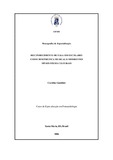| dc.contributor.advisor | Tochetto, Tania Maria | |
| dc.creator | Gambini, Caroline | |
| dc.date.accessioned | 2016-08-03T14:02:07Z | |
| dc.date.available | 2016-08-03T14:02:07Z | |
| dc.date.issued | 2006-01-27 | |
| dc.date.submitted | 2006 | |
| dc.identifier.uri | http://repositorio.ufsm.br/handle/1/1949 | |
| dc.description | Monografia (especialização) - Universidade Federal de Santa Maria, Centro de Ciências da Saúde, Curso de Especialização em Fonoaudiologia, RS, 2006. | por |
| dc.description.abstract | The effective communication mainly depends on the human being´s capacity in
understanding the speech. Many hearing habilities are involved in this process and can
be improved with an auditory trainning, becoming an agent that favours the recognition
process of the speech. One of the basis of this practice is the plasticity of the central
auditory nervous system. For this reason, this research was developed to compare the
recognition hability in silence and in noise in students with or without musical practice
of different social and cultural levels. Ten children that had had early musical initiation
by Suzuki Method (Group A) participated in this study, 15 children of the Army School
in Santa Maria (Group B) and 15 children of a Philanthropy School mantained by a
Spiritual Society for Study and Charity, also known as Joaquina´s Home (Group C). All
volunteers were normal hearing and without otologics complaints, with ages among 7
and 13 years old. A detailed report, inspection of the external acoustic meatus, pure
tone audiometry, survey of the speech threshold recognition and speech recognition
percent index were done. For Sentence Recognition Threshold (SRT) in Silence and in
Noise, it was used the Statement List in Portuguese (Costa, 1998). From the SRT in
noise, the Relation Sign/Noise (S/N) was obtained. The statements and the noise (fixed
at 65 dB HL) were presented ear by ear by ear phones, by the increasing-decreasing
strategy (Levitt & Rabiner, 1967). The following results were obtained: Group A: SRT
in quiet = 6,60 dB HL and S/R = -3,94 dB HL; Group B: SRT in quiet = 7,57 dB HL
and S/R = -4,61 dB HL and Group C: SRT in quiet = 10,43 dB HL and S/R = -1,54 dB
HL. There was a statistically difference among Group C and the two other groups in
both evaluated aspects. It was conclued that the social and cultural levels, not
concerning the trainning of the hearing habilities by the early musical practice, can
affect the hability in recognizing the speech. | eng |
| dc.language | por | por |
| dc.publisher | Universidade Federal de Santa Maria | por |
| dc.rights | Acesso Aberto | por |
| dc.subject | Fonoaudiologia | por |
| dc.subject | Audição | por |
| dc.subject | Fala | por |
| dc.subject | Reconhecimento da fala | por |
| dc.subject | Prática musical | por |
| dc.subject | Crianças | por |
| dc.title | Reconhecimento de fala em escolares com e sem prática musical e diferentes níveis sócio-culturais | por |
| dc.title.alternative | “Speech recognition in students with or without musical practice of different social and cultural levels” | eng |
| dc.type | Trabalho de Conclusão de Curso de Especialização | por |
| dc.degree.local | Santa Maria, RS, Brasil. | por |
| dc.degree.specialization | Fonoaudiologia | por |
| dc.description.resumo | A comunicação efetiva depende principalmente da capacidade do ser humano
compreender a fala. Muitas habilidades auditivas estão envolvidas neste processo e
podem ser aprimoradas com o treinamento auditivo, tornando-se um agente facilitador
do processo de reconhecimento da fala. Um dos fundamentos dessa prática é a
plasticidade do sistema nervoso auditivo central. Por esta razão, desenvolveu-se esta
pesquisa com o objetivo de comparar a habilidade de reconhecimento de fala no silêncio
e no ruído em escolares com e sem prática musical e de diferentes níveis sócio-culturais.
Participaram deste estudo 10 crianças que tiveram iniciação musical precoce por meio
do Método Suzuki (Grupo A), 15 crianças alunas do Colégio Militar de Santa Maria
(Grupo B) e 15 crianças alunas de uma Escola Filantrópica mantida pela Sociedade
Espírita Estudo e Caridade, também conhecida como Lar de Joaquina (Grupo C). Todos
os voluntários eram normo-ouvintes e sem queixas otológicas, com idade variando de 7
a 13 anos. Foi realizada anamnese, inspeção do meato acústico externo, audiometria
tonal liminar, pesquisa do limiar de reconhecimento de fala e índice perceptual de
reconhecimento de fala. Para realização da pesquisa do Limiar de Reconhecimento de
Sentenças no Silêncio (LRSS) e no Ruído (LRSR), utilizou-se o teste Lista de Sentenças
em Português (LSP) (Costa, 1998). A partir do LRSR, obteve-se a Relação Sinal/Ruído
(S/R). As sentenças e o ruído (fixo a 65 dB NA) foram apresentados monoauralmente,
por fones auriculares, através da estratégia ascendente-descendente (Levitt & Rabiner,
1967). Os seguintes resultados foram obtidos: Grupo A: LRSS = 6,60 dB NA e S/R = -
3,94 dB NA; Grupo B: LRSS = 7,57 dB NA e S/R = -4,61 dB NA e Grupo C: LRSS =
10,43 dB NA e S/R = -1,54 dB NA. Verificou-se diferença estatisticamente significante
entre o Grupo C e os dois demais grupos em ambos os aspectos avaliados. Concluiu-se que o nível sócio-cultural, independentemente do treinamento das habilidades auditivas por meio de prática musical precoce, pode afetar a habilidade de reconhecimento de fala. | por |
| dc.publisher.unidade | Centro de Ciências da Saúde | por |


